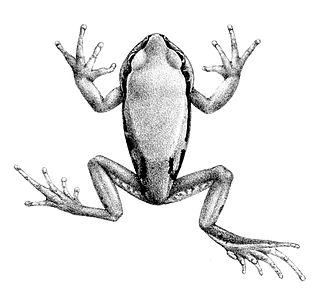
Bale Mountains National Park (BMNP) is a national park in Ethiopia. The park encompasses an area of approximately 2,150 km2 (830 sq mi) in the Bale Mountains and Sanetti Plateau of the Ethiopian Highlands.
Altiphrynoides is a genus of toads, commonly referred to as Ethiopian toads. They are restricted to highlands of south-central Ethiopia in the Arussi, Bale and Sidamo Provinces. Both species are threatened by habitat loss. They were formerly included in Nectophrynoides, but lack the unusual reproductive mode of those species. Conversely, some authorities treat Altiphrynoides as a monotypic genus for A. malcolmi, placing A. osgoodi in another monotypic genus, Spinophrynoides.
The Ethiopian long-eared bat or Ethiopian big-eared bat is a recently described species of long-eared bat in the family Vespertilionidae.
Malcolm's Ethiopian toad or the Ethiopian mountain toad, Altiphrynoides malcolmi, is a species of toad in the family Bufonidae endemic to the Bale Mountains of Ethiopia. Its natural habitats are Schefflera-Hagenia-Hypericum forests and Afro-alpine moorland, and the transition zone in between. It is threatened by habitat loss and is listed by the IUCN as being an "endangered species".

Atelopus certus, the Darien stubfoot toad or Toad Mountain harlequin frog, is a species of toad in the family Bufonidae endemic to Panama.
Nannophryne corynetes, the Abra Malaga toad, is a species of toad in the family Bufonidae that is endemic to Peru and only found in the region of the type locality in the Urubamba Province. Its natural habitats are forest edges restricted to the zone of puna grassland directly adjacent to montane forest. Breeding habitat is unknown but probably aquatic. It is a very rare species but there are no immediate threats to it.

Incilius ibarrai is a species of toad in the family Bufonidae. It is found in the central and southern highlands of Guatemala and adjacent Honduras. The specific name ibarrai honors Jorge Alfonso Ibarra (1921–2000), then-director of the Guatemalan National Natural History Museum.
Nectophrynoides laevis, the smooth forest toad, is a species of toad in the family Bufonidae.
Nectophrynoides vestergaardi, also known as the Vestergaard's forest toad, is a species of toad in the family Bufonidae. It is endemic to the West Usambara Mountains, Tanzania. It is named in honour of Martin Vestergaard, the Danish biologist who was the first to recognize that the population now described as Nectophrynoides vestergaardi was a new species.
Schmidt's mountain brook frog is a species of frog in the family Hylidae. It is endemic to the Pacific slopes of the Sierra Madre de Chiapas in southwestern Guatemala and southern Mexico in eastern Oaxaca and southwestern Chiapas. It is named after Karl Patterson Schmidt, American herpetologist, and his brother Frank, who collected with him.

Leptopelis gramineus is a species of frog in the family Arthroleptidae. It is endemic to Ethiopia and occurs on the Ethiopian Highlands on both sides of the Great Rift Valley. Common names Badditu forest treefrog and Ethiopian burrowing tree frog have been coined for it.
Paracassina kounhiensis is a species of frog in the family Hyperoliidae. It is endemic to Ethiopian highlands east of the Rift Valley. Its natural habitats is montane grassland, less commonly the margins of montane forest. It breeds in marshes and pools. While still locally abundant, it is threatened by habitat loss. A part of its range is within the Bale Mountains National Park.
The Medog horned toad, or Medog spadefoot toad, is a species of frog in the family Megophryidae. It was described as a subspecies of Omei horned toad based on specimens collected from Mêdog County, Tibet (China); it is still only known from its type locality. It probably has a wider distribution that may reach India. Its natural habitats are subtropical or tropical moist lowland forests, subtropical or tropical moist montane forests, and rivers.
The Bale Mountains tree frog is a species of frogs in the family Brevicipitidae. It is the only species in the monotypic genus Balebreviceps and endemic to the Bale Mountains of Ethiopia. Its natural habitats are tree heath woodland near the timberline as well as partly cleared mixed forest further down. Despite its entire range being within the Bale Mountains National Park, it is threatened by habitat loss and deterioration (deforestation) caused by cattle grazing, firewood collection, fencing, and settlement development.
Ptychadena nana is a species of frog in the family Ptychadenidae. It is endemic to Ethiopia. It is only known with certainty from its type locality, Arussi Mountains, in the Ethiopian Highlands; these mountains are also referred to as the Arsi Mountains. There is uncertainty regarding reports from elsewhere, which perhaps refer to other, possibly undescribed species. Freilich and colleagues found specimens from the Bale Mountains to be larger than "normal" Ptychadena nana, but that molecular data clustered them with other P. nana. Common names Somali grassland frog and smallest grass frog have been coined for it.
Nectophrynoides laticeps is a species of toad in the family Bufonidae. It is endemic to the Ukaguru Mountains of Tanzania. Common name wide-headed viviparous toad has been proposed for it.

The Harenna Forest is a montane tropical evergreen forest in Ethiopia's Bale Mountains. The forest covers the southern slope of the mountains, extending from 1450 to 3200 meters elevation. The Bale Mountains are in Ethiopia's Oromia Region, and form the southwestern portion of the Ethiopian Highlands.
Harena Buluk is one of the woredas in the Oromia Region of Ethiopia. It was part of former Menna Angetu woreda. It is part of the Bale Zone. Harena Buluk woreda is bordered on the south by Meda Welabu, on the north by Goba, on the west by Nensebo, on the northwest by Adaba, and on the east by [[Delo Menna, Oromia (woreda). The administrative center for the woreda is Angetu.





